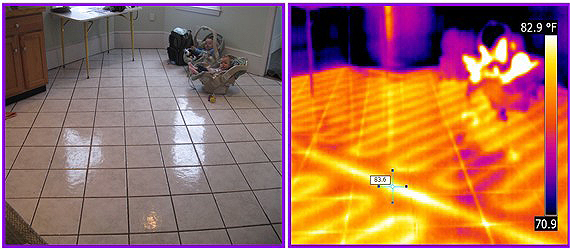Infrared Thermal Imaging

Thermal Imaging is a valuable tool that can have a significant impact on troubleshooting and Home Inspection productivity, as well as the bottom line, for Moisture, Energy Lost, HVAC, Plumbing, Electrical and most Building applications.
Thermal imaging is a method of improving visibility of objects in a dark environment by detecting the objects' infrared radiation and creating an image based on that information.
Here's a brief explanation of how thermal imaging works: All objects emit infrared energy (heat) as a function of their temperature. The infrared energy emitted by an object is known as its heat signature.
In general, the hotter an object is, the more radiation it emits. A thermal imager (also known as a thermal camera) is essentially a heat sensor that is capable of detecting tiny differences in temperature.
The device collects the infrared radiation from objects in the scene and creates an electronic image based on information about the temperature differences. Because objects are rarely precisely the same temperature as other objects around them, a thermal camera can detect them and they will appear as distinct in a thermal image.
How important is the use of IR, (infrared) Thermal Imaging for a typical inspection? It all depends. We can only see what we see during an inspection and if it’s hidden to us it’s called a latent defect and without this technology we could miss something, maybe minor or worst case scenario, a major flaw or even a cover-up. Legal definition of Latent defects are hidden flaws, weaknesses or imperfections of building components, which a seller knows about, but the buyer cannot discover by a reasonable visual inspection.
Even an "as is" purchase could be rescinded if it could be shown the seller knew about the flaw and took steps to cover it up.
Generally, this entitles the purchaser to get his/her money back, (rescind the deal) or get a replacement without a defect on the basis of an “implied” warranty of quality that a buyer could expect “merchantability,” the goods must reasonably conform to an ordinary buyer’s expectations, i.e., they are what they say they are.
Not to get ahead of ourselves, most people are honest and sometimes they didn’t know that these flaws or defects existed and with the use of the FLIR tools and a thorough examination of the home inspection, AHI will deliver a concise report with images that describes every aspect, small or large of the house in question, and to further assess its needs for the client. Think of the IR tool as similar to a doctor’s exanimation of his/her patient’s complaints without an X-ray or an MRI?
FLIR uses MSX, Multi Spectral Dynamic Imaging technology. Unlike traditional thermal fusion that inserts a thermal image into a visible-light picture, FLIR’s new MSX embosses digital camera detail onto thermal video and stills for better clarity.
AHI will charge a minimum fee for the use of this equipment to enhance the findings for the final report. If AHI see a situation or has some concerns about any possible hidden defects during an inspection the inspector will advise the client during the inspection of whether or not it may be necessary for further investigation. But only after a discussion with the client in the field and a logical description of the problems that the inspector believes needs further attention.
Areas that are covered during IR Thermal Imaging:
A. Possible trapped moisture or breaches inside of walls, ceilings and floors and especially with a roofing system.
B. Serious energy losses with HVAC systems and ducts.
C. Hot spots within electrical circuity that could be a fire hazard.
D. Continuity of plumping pipes and radiant floors either hydronic or electrical.

STARTING AT: $199.00 as a Standalone Service, although it is included with our Typical Inspection...
Infrared Certified

The FLIR Infrared Thermal Imaging tool takes two pictures simultaneously to illustrate what the naked eye sees first,
and second the depth of what the IR imaging records inside of a typical building surface and beyond.


